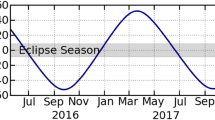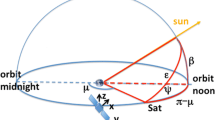Abstract
A simplified yaw-attitude modeling, consistent with Bar-Sever (1996), has been implemented and tested in the NRCan PPP software. For Block IIR GPS satellite it is possible to model yaw-attitude control during eclipsing periods by using the constant hardware yaw rate of 0.20°/s. The Block IIR satellites maintain the nominal yaw attitude even during a shadow crossing (Y. E. Bar-Sever, private communication, 2007), except for the noon and shadow midnight turn maneuvers, both of which can be modeled and last up to 15 min. Thus, for Block IIR satellites it is possible to maintain continuous satellite clock estimation even during eclipsing periods. For the Block II/IIA satellites, it is possible to model satisfactorily the noon turns and also shadow crossing, thanks to the permanent positive yaw bias of 0.5°, implemented in November 1995. However, in order to model the Block II/IIA shadow crossings, satellite specific yaw rates should be used, either solved for or averaged yaw-rate solutions. These yaw rates as estimated by the Jet Propulsion Laboratory (JPL) can differ significantly from the nominal hardware values. The Block II/IIA post-shadow recovery periods, which last about 30 min, should be considered uncertain and cannot be properly modeled. Data from post-shadow recovery periods should, therefore, not be used in precise global GPS analyses (Bar-Sever 1996). For high-precision applications, it is essential that users implement a yaw-attitude model, which is consistent with the generation of the satellite clocks. Initial testing and analyses, based on the IGS and AC Final orbits and clocks have revealed that during eclipsing periods, significant inconsistencies in yaw-attitude modeling still exist amongst the IGS Analyses Centers, which contribute to the errors of the IGS Final clock combinations.












Similar content being viewed by others
References
Bar-Sever YE (1996) A new model for GPS yaw-attitude. JoG 70:714–723
Beutler G, Brockmann E, Gurtner W, Hugentobler U, Mervart L, Rothacher M, Verdun A (1994) Extended orbit modeling technique at CODE processing center of the international GPS service for geodynamics (IGS): theory and initial results. Manuscr Geod 19:367–386
Dow JM, Neilan RE, Gendt G (2005) The International GPS Service (IGS): celebrating the 10th Anniversary and looking to the next decade. Adv Space Res 36(3):320–326. doi:10.1016/j.asr.2005.05.125
Héroux P, Kouba J (2001) GPS precise point positioning with IGS orbit products. Phys Chem Earth A 26:573–578
IGS Mail # 591: http://igscb.jpl.nasa.gov/mail/igsmail/1994/msg00166.html
IGS Mail # 1653: http://igscb.jpl.nasa.gov/mail/igsmail/1997/msg00151.html
Wu JT, Wu SC, Hajj GA, Bertiger WI, Lichten SM (1993) Effects of antenna orientation on GPS carrier phase. Manuscr Geod 18:91–98
Acknowledgements
IGS data and Final solution products (Dow et al. 2005) were analyzed and used here. Pierre Tetreault of NRCan has kindly agreed to read this paper and provided the author with useful suggestions and comments.
Author information
Authors and Affiliations
Corresponding author
Rights and permissions
About this article
Cite this article
Kouba, J. A simplified yaw-attitude model for eclipsing GPS satellites. GPS Solut 13, 1–12 (2009). https://doi.org/10.1007/s10291-008-0092-1
Received:
Accepted:
Published:
Issue Date:
DOI: https://doi.org/10.1007/s10291-008-0092-1




